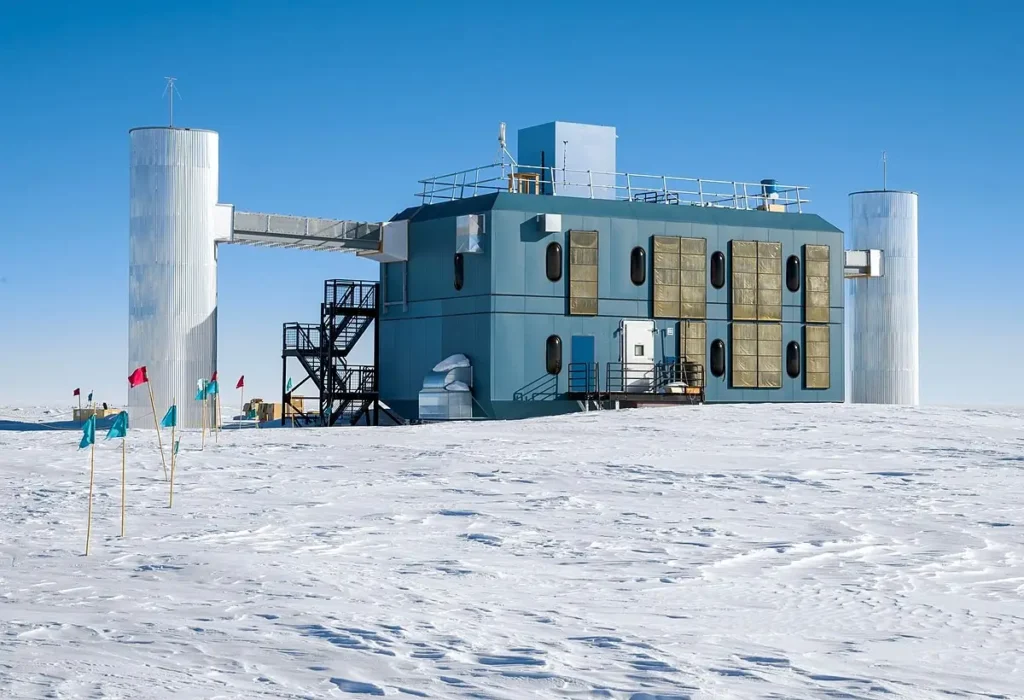Scientists from the IceCube Neutrinos Observatory have announced the discovery of evidence for astrophysical tau neutrinos, marking a significant advancement in understanding of cosmic phenomena.
About Neutrinos:
- Neutrinos are subatomic particles that are similar to electrons but have no electrical charge and a very small mass.
- They are one of the most abundant particles in the universe, but they are difficult to detect because they have very little interaction with matter.
- This means that they can travel massive distances undisturbed and that in turn means that it is much easier to trace them back to their source, helping in understanding more about the distant universe.
- They are electrically neutral and interact only via the weak interaction and gravity.
- They can pass through almost anything without being stopped.
- For example, every second, about 400 billion neutrinos from the sun pass through each person on Earth.
- They are unaffected by magnetic fields and travel essentially at the speed of light.
- They are produced by nuclear reactors, radioactive decay, particle accelerators, the sun, the Earth, and the cosmos.
- Astrophysical neutrinos: Astrophysical neutrinos refer to high-energy neutrinos originating from farthest reaches beyond Milky Way galaxy.
Flavours of Neutrinos:
- They come in three distinct “flavors“: electron, muon, and tau.
- These names come from the fact that when neutrinos interact with protons or neutrons, they can produce electrons, muons, or tau leptons.
- The tau neutrino, in particular, has been challenging to observe and detect, earning the nickname “ghost particle.”
- Tau neutrinos are difficult to observe because they are heavy, decay rapidly, and are hard to produce in abundance.
About IceCube, the South Pole Neutrino Observatory:
- IceCube, the South Pole neutrino observatory, is a cubic-kilometer particle detector made of Antarctic ice and located near the Amundsen-Scott South Pole Station.
- It is the first gigaton neutrino detector ever built and was primarily designed to observe neutrinos from the most violent astrophysical sources in the universe.
- It employs “strings” (cables) of digital optical modules (DOMs) embedded deep within Antarctic ice to detect neutrinos.
- Neutrino interactions with the ice produce charged particles that emit blue light, which is detected and digitized by individual DOMs.
- In 2013, IceCube presented its initial evidence of high-energy astrophysical neutrinos originating from cosmic accelerators.
The India-based Neutrino Observatory (INO) Project:
- INO is a particle physics research project that involves building a 1,200-meter deep underground laboratory.
- The project’s primary goal is to study the properties and interactions of neutrinos.
- Ministry/Department: Department of Atomic Energy (DAE) & Department of Science and Technology (DST).
- Nodal Centre: Tata Institute of Fundamental Research (TIFR), Mumbai
- Location: The project is located in a cave under INO Peak in Pottipuram, Bodi West Hills region of Tamil Nadu’s Theni district.
Ref:Source
| UPSC IAS Preparation Resources | |
| Current Affairs Analysis | Topperspedia |
| GS Shots | Simply Explained |
| Daily Flash Cards | Daily Quiz |



